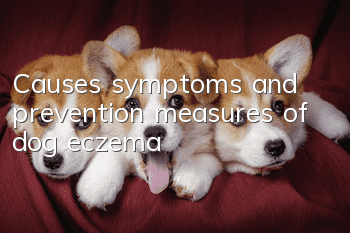Causes, symptoms and prevention measures of dog eczema

The causes of dog eczema:
1. It is caused by stimulation from various factors, under the action of external physical factors and chemical factors, such as mechanical compression, Friction, bites, scratches, mosquito bites; certain internal medicines, topical medicines, disinfectants; unclean skin, irritation from dirt, etc.
2. Poor feeding and management conditions, such as moisture in the kennel, can stimulate the body, cause skin allergies, and cause eczema. Excessive carbohydrate intake is more likely to cause eczema. The disease is more common in seasons with higher temperatures and higher humidity. In my country, summer and autumn are the most common seasons, especially May to September.
3. Nutritional deficiency. If the dog lacks vitamins and trace elements, the dog's skin will have low resistance and may also cause eczema.
Symptoms of dog eczema:
1. Acute eczema: At the beginning of the disease, the affected area appears as punctate or erythematous eczema of different shapes, and the affected dog may feel itching. As the disease progresses, papules, vesicles, pustules, and erosion stages may appear. For example, in the pustular and erosive stages, most people have microbial infection, the skin has an abnormal odor, and there is skin itching. Sometimes dogs cause skin damage due to scratching and friction, which aggravates dermatitis. Typical acute eczema presents as small moist papules with scattered small blisters on the papules, and some may be dissipated.
2. Chronic eczema: mostly caused by the transformation of acute eczema. Repeated stimulation and repeated attacks are characterized by thickening of the skin, desquamation, pigmentation, rough coat, inverse erection, and increased itching. More common on the back or limbs.
Prevention and treatment measures for dog eczema:
1. Desensitize, stop exudation, prevent infection, and promote recovery.
2. Adrenocortical hormone therapy: use dexamethasone tablets 0.2 mg/kg body weight, orally or prednisone acetate tablets 1.0 mg/kg body weight, orally. Apply fluocinolone acetonide or triamcinolone acetonide ointment to the affected skin. To prevent skin infection, apply it alternately with erythromycin ointment.
3. In the pus cell stage, penicillin and gentamicin can be injected intramuscularly to prevent infection. In cases with severe symptoms, it can be mixed with dexamethasone injection and injected intramuscularly, twice a day.
4. Reduce or stop self-injury and relieve itching. You can give a sedative or put a collar on the sick dog to prevent it from continuing to bite the affected area.
5. Carry out drug treatment. After using antibiotics and steroid drugs together for 24 hours, the wound will dry and scab will form in a few days.
- What to do if Bichon Frize lacks calcium after delivery?
- Causes and treatments of bad breath in dogs
- Everything you need to know before training your dog can be taught to anyone as long as you know how to do it!
- How to remove tear stains on Maltese dogs, recommended to collect!
- Bichon Frize training methods and techniques to make it good and obedient!
- How to disinfect dogs during the epidemic? All pet-raising families use this disinfectant!
- What's wrong with my dog's breasts being so hard?
- Doting on dogs may lead to their death
- What foods are Tibetan Mastiffs prone to poisoning?
- Greyhound training methods_How to train Greyhound?



